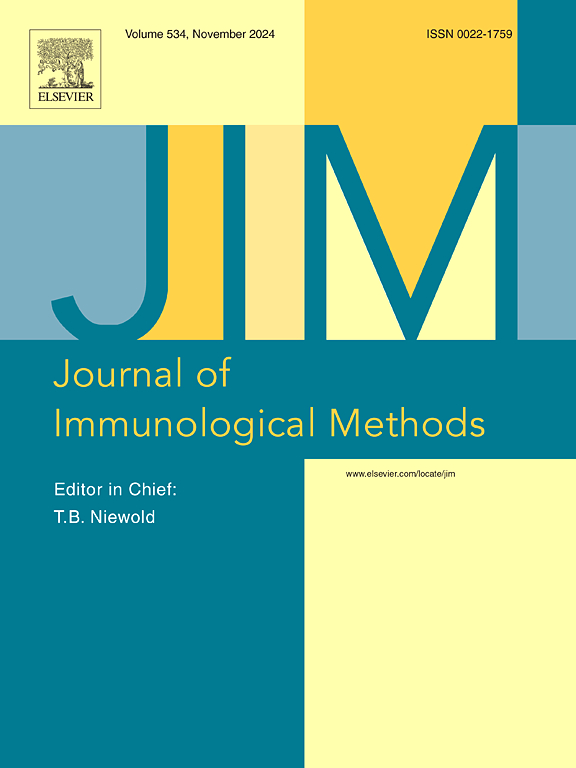Characterization of antigen B subunit 2 (AgB2) gene polymorphism in sheep isolates of Echinococcus granulosus sensu lato and effect on serologic response
IF 1.6
4区 医学
Q4 BIOCHEMICAL RESEARCH METHODS
引用次数: 0
Abstract
Cystic Echinococcosis (CE) is one of the most common helminth infections in many parts of the world. Antigen B (AgB) is a key molecule secreted by both the germinal membrane and protoscoleces during the larval stages of Echinococcus granulosus. Characterizing polymorphisms in the genes encoding AgB can improve the interpretation of serological diagnostic tests. This study aimed to determine the polymorphism in the AgB subunit 2 (AgB2) gene in sheep isolates of E. granulosus sensu lato and to investigate its effect on the serological response. Germinal membranes from 41 sheep hydatid cysts and corresponding blood serum samples were collected from slaughterhouses in Elazig and Bingol provinces of Türkiye. Total genomic DNA was isolated, and PCR amplification of the AgB2 gene region was followed by DNA sequencing to evaluate genetic diversity. Western Blot (WB) analysis was performed using partially purified cyst fluid antigen rich in AgB. Sequence analysis revealed that the 663 bp AgB2 gene region exhibited high polymorphism. A total of 33 polymorphic sequences were identified and classified into 10 different haplotypes (AgB2.Hap_01 to AgB2.Hap_10). Among these, 31 (93.9 %) samples were WB-positive, while 2 (6.1 %) were negative. The WB test demonstrated a sensitivity of 80.4 % and a specificity of 100 %. These results suggest a relationship between the polymorphism in the AgB2 gene and variations in the serological response.
绵羊感细粒棘球绦虫抗原B亚基2 (AgB2)基因多态性特征及其对血清学反应的影响
囊性包虫病(CE)是世界上许多地区最常见的寄生虫感染之一。抗原B (Antigen B, AgB)是细粒棘球绦虫幼虫期生发膜和原头节分泌的关键分子。表征编码AgB基因的多态性可以改善血清学诊断测试的解释。本研究旨在检测绵羊分离物中AgB亚基2 (AgB2)基因的多态性,并探讨其对血清反应的影响。在塔吉克斯坦埃拉兹格省和Bingol省的屠宰场采集了41只羊包虫的生发膜和相应的血清样本。分离总基因组DNA,对AgB2基因区域进行PCR扩增,并进行DNA测序,评估遗传多样性。使用部分纯化的富含AgB的囊液抗原进行Western Blot (WB)分析。序列分析显示,663 bp的AgB2基因区具有较高的多态性。共鉴定出33个多态性序列,并将其划分为10个不同的单倍型(AgB2;Hap_01到AgB2.Hap_10)。其中wb阳性31份(93.9%),阴性2份(6.1%)。WB试验的敏感性为80.4%,特异性为100%。这些结果表明,AgB2基因多态性与血清学反应的变化之间存在关系。
本文章由计算机程序翻译,如有差异,请以英文原文为准。
求助全文
约1分钟内获得全文
求助全文
来源期刊
CiteScore
4.10
自引率
0.00%
发文量
120
审稿时长
3 months
期刊介绍:
The Journal of Immunological Methods is devoted to covering techniques for: (1) Quantitating and detecting antibodies and/or antigens. (2) Purifying immunoglobulins, lymphokines and other molecules of the immune system. (3) Isolating antigens and other substances important in immunological processes. (4) Labelling antigens and antibodies. (5) Localizing antigens and/or antibodies in tissues and cells. (6) Detecting, and fractionating immunocompetent cells. (7) Assaying for cellular immunity. (8) Documenting cell-cell interactions. (9) Initiating immunity and unresponsiveness. (10) Transplanting tissues. (11) Studying items closely related to immunity such as complement, reticuloendothelial system and others. (12) Molecular techniques for studying immune cells and their receptors. (13) Imaging of the immune system. (14) Methods for production or their fragments in eukaryotic and prokaryotic cells.
In addition the journal will publish articles on novel methods for analysing the organization, structure and expression of genes for immunologically important molecules such as immunoglobulins, T cell receptors and accessory molecules involved in antigen recognition, processing and presentation. Submitted full length manuscripts should describe new methods of broad applicability to immunology and not simply the application of an established method to a particular substance - although papers describing such applications may be considered for publication as a short Technical Note. Review articles will also be published by the Journal of Immunological Methods. In general these manuscripts are by solicitation however anyone interested in submitting a review can contact the Reviews Editor and provide an outline of the proposed review.

 求助内容:
求助内容: 应助结果提醒方式:
应助结果提醒方式:


